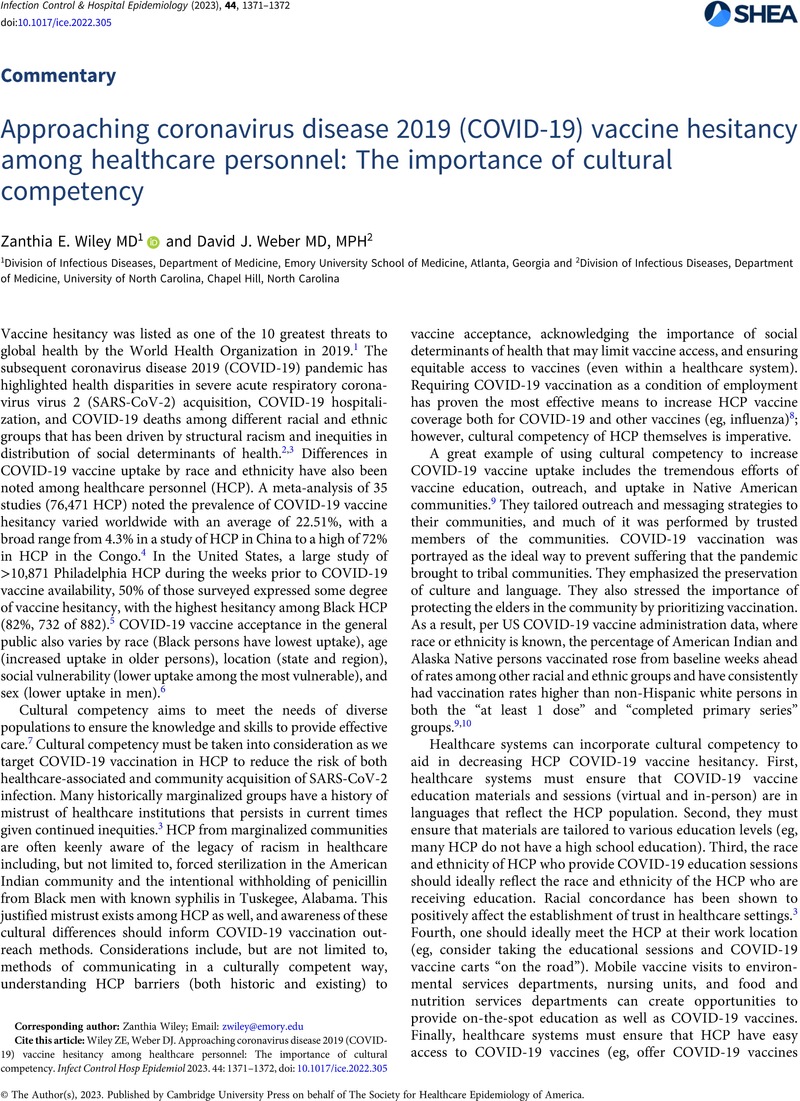No CrossRef data available.
Article contents
Approaching coronavirus disease 2019 (COVID-19) vaccine hesitancy among healthcare personnel: The importance of cultural competency
Published online by Cambridge University Press: 18 July 2023
Abstract
An abstract is not available for this content so a preview has been provided. Please use the Get access link above for information on how to access this content.

- Type
- Commentary
- Information
- Copyright
- © The Author(s), 2023. Published by Cambridge University Press on behalf of The Society for Healthcare Epidemiology of America
References
WHO ten threats to global health in 2019. World Health Organization website. https://www.who.int/news-room/spotlight/ten-threats-to-global-health-in-2019. Accessed May 20, 2022.Google Scholar
Risk for COVID-19 infection, hospitalization, and death by race/ethnicity. Centers for Disease Control and Prevention website. https://www.cdc.gov/coronavirus/2019-ncov/covid-data/investigations-discovery/hospitalization-death-by-race-ethnicity.html. Accessed May 20, 2022.Google Scholar
Marcelin, JR, Swartz, TH, Bernice, F, et al. Addressing and inspiring vaccine confidence in black, indigenous, and people of color during the coronavirus disease 2019 pandemic. Open Forum Infect Dis 2021;8:ofab417.CrossRefGoogle ScholarPubMed
Biswas, N. The nature and extent of COVID-19 vaccine hesitancy in healthcare workers. J Commun Health 2021;46:1244–1251.10.1007/s10900-021-00984-3CrossRefGoogle ScholarPubMed
Momplaisir, FM, Kuter, BJ, Ghadimi, F, et al. Racial/ethnic differences in COVID-19 vaccine hesitancy among healthcare workers in 2 large academic hospitals. JAMA Netw Open 2021;4:e2121931.10.1001/jamanetworkopen.2021.21931CrossRefGoogle ScholarPubMed
COVID data tracker—vaccination distribution and coverage. Centers for Disease Control and Prevention website. https://covid.cdc.gov/covid-data-tracker/#vaccine-delivery-coverage. Accessed June 8, 2022.Google Scholar
McGregor, B, Belton, A, Henry, TL, Wrenn, G, Holden, KB. Improving behavioral health equity through cultural competence training of healthcare providers. Ethn Dis 2019;29 suppl 2:359–364.10.18865/ed.29.S2.359CrossRefGoogle Scholar
Weber, DJ, Al-Tawfiq, JA, Babcock, HM, Bet al. Multisociety statement on coronavirus disease 2019 (COVID-19) vaccination as a condition of employment for healthcare personnel. Infect Control Hosp Epidemiol 2022;43:3–11.10.1017/ice.2021.322CrossRefGoogle ScholarPubMed
Foxworth, R, Redvers, N, Moreno, MA, Lopez-Carmen, VA, Sanchez, GR, Shultz, JM. COVID-19 vaccination in American Indians and Alaska Natives—lessons from effective community responses. N Engl J Med 2021;385:2403–2406.10.1056/NEJMp2113296CrossRefGoogle ScholarPubMed
CDC data tracker trends in demographic characteristics of people receiving COVID-19 vaccinations in the United States. Centers for Disease Control and Prevention website. https://covid.cdc.gov/covid-data-tracker/#vaccination-demographics-trends Accessed November 13, 2022.Google Scholar



